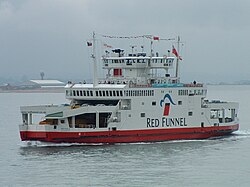| Port of Southampton | |
|---|---|
 | |
 | |
| Location | |
| Country | United Kingdom |
| Location | Southampton, England |
| Coordinates | 50°53′47″N1°23′48″W / 50.8965°N 1.3968°W |
| Details | |
| Operated by | Associated British Ports |
| No. of berths | 45 (20–49, 101–110, 200–207) |
| Statistics | |
| Website Port of Southampton | |
The Port of Southampton is a passenger and cargo port in the central part of the south coast of England. The modern era in the history of the Port of Southampton began when the first dock was inaugurated in 1843. After the Port of Felixstowe, Southampton is the second largest container terminal in the United Kingdom, with a handled traffic of 1.5 million twenty-foot equivalent units (TEU). [1] It also handles cruise ships, roll-on roll-off, dry bulk, and liquid bulk (mainly crude oil). [1]
Contents
- Cruise shipping
- Passenger terminals
- Operators
- Freight and cargo
- Containers
- Vehicles
- Bulk cargos
- Perishable foods
- Oil and petroleum products
- Local ferries
- Cross-Solent ferries
- Hythe ferry
- Port services
- Towage
- Bunkering
- Boats and small ships
- Marinas
- Harbour and local pleasure cruises
- Boat show
- Outer areas of the port
- Southampton Water
- River Itchen
- River Test
- Other activities
- References
In 2015, DP World extended its operating license for DP World Southampton until 2047, following a deal with Associated British Ports (ABP). [1] DP World is the sole owner of DP World Southampton, having acquired ABP's 49 per cent stake, having been owned and operated by ABP since 1982. [1]
It is the busiest cruise terminal and second largest container port in the UK. By volume of port traffic, Southampton is a Medium-Port City globally. [2]
The port is located between the confluence of the rivers Test and Itchen at the head of the mile-wide drowned valley known as Southampton Water. The mouth of the inlet is protected from the effects of foul weather by the mass of the Isle of Wight, which gives the port a sheltered location. Additional advantages include: a densely populated hinterland; proximity to London, and good rail and road links to the rest of Britain which bypass the congestion of London.
The average tidal range is approximately 4 metres (13 feet), with 17 hours per day of rising water thanks to the port's "double tides". These allow the largest container and cruise ships access to the port for up to 80 per cent of the time, according to the container terminal operator DP World Southampton. This is a result of tidal flow through the English Channel: high tide at one end of the Channel (Dover) occurs at the same time as low tide at the other end (Land's End). Points near the centre have one high water as the tidal swell goes from west to east, another as it then goes from east to west. Neither is as high as the one at each end of the English Channel. [3]
The principal berths are divided into three areas:
- The Old Docks at the junction of the Rivers Test and Itchen, consisting of berths 20–49
- The New Docks, known as the Western Docks, [4] built by the Southern Railway, consisting of Berths 101–110; and
- The Container Terminal, originally consisting of berths 201–207. This terminal was constructed entirely on reclaimed land, with berth 201 opening in 1968. [5] However the berths at the container terminal have since been renamed. Berths 207 to 204 are now berths SCT 1 to 4 respectively, and the reconstructed berths 201/202 now SCT 5.


















